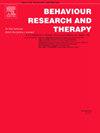对于精神病理学的跨诊断风险标志,有偏见和不灵活的更新解释是广泛的还是狭窄的?精神病理学分级分类法(HiTOP)镜头
IF 4.5
2区 心理学
Q1 PSYCHOLOGY, CLINICAL
引用次数: 0
摘要
先前的研究已经将对模糊信息的偏见和不灵活的解释与各种形式的精神病理学联系起来。然而,现有的研究通常是在个体诊断类别中调查这些解释过程,忽略了精神健康状况中显著的症状重叠和合并症。因此,有偏见和不灵活的解释在多大程度上代表广泛的跨诊断或更狭隘的特定风险因素仍不清楚。为了解决这一差距,本研究使用精神病理学分级分类法(HiTOP)调查了有偏见和不灵活的解释过程与精神病理学维度之间的跨诊断关联。HiTOP是一个数据驱动的框架,旨在跨越传统的诊断界限整合精神病理症状。一群来自社区的成年人样本(N = 383)完成了HiTOP自我报告和对不证实证据的情绪偏见任务。这项任务测量消极和积极的解释偏见,以及在社会环境中不灵活的消极解释。采用双因素潜在回归模型来检验解释过程与精神病理学的一般p因子(代表障碍共有方差的总体维度)和五个HiTOP谱(内化、思维障碍、去抑制外化、对抗性外化、超脱)之间的关联。p因子与负性解释偏差和负性解释不灵活性显著相关。减少的积极解释偏差与超然谱系有独特的关系,其特征是情感超然、社会冷漠和回避社会关系。这些发现表明,消极偏见和不灵活的解释可能代表了精神病理学的一般跨诊断风险标志,而减少的积极解释偏见可能是分离相关疾病的更具体的风险因素。未来的研究应该探索不灵活的解释过程导致广义和频谱特异性精神病理风险的机制。本文章由计算机程序翻译,如有差异,请以英文原文为准。
Are biased and inflexible updating of interpretations broad or narrow transdiagnostic risk markers for psychopathology? A Hierarchical Taxonomy of Psychopathology (HiTOP) lens
Previous research has linked biased and inflexible interpretations of ambiguous information to various forms of psychopathology. However, existing studies typically investigate these interpretation processes within individual diagnostic categories, overlooking the significant symptom overlap and comorbidity among mental health conditions. Consequently, the extent to which biased and inflexible interpretations represent broad transdiagnostic or more narrowly specific risk factors remains unclear. To address this gap, this study investigated transdiagnostic associations between biased and inflexible interpretation processes and dimensions of psychopathology using the Hierarchical Taxonomy of Psychopathology (HiTOP). HiTOP is a data-driven framework designed to integrate psychopathology symptoms across traditional diagnostic boundaries. A crowdsourced community sample of adults (N = 383) completed a HiTOP self-report battery and the emotional Bias Against Disconfirmatory Evidence task. This task measures negative and positive interpretation biases, as well as inflexible negative interpretations in social contexts. Bi-factor latent regression modeling was employed to examine associations between interpretation processes and both the general p-factor of psychopathology (an overarching dimension representing shared variance across disorders) and five HiTOP spectra (internalizing, thought disorder, disinhibited externalizing, antagonistic externalizing, detachment). The p-factor showed significant associations with negative interpretation bias and negative interpretation inflexibility. Reduced positive interpretation bias was uniquely associated with the detachment spectrum, which is characterized by emotional detachment, social disinterest, and avoidance of social relationships. These findings suggest that negatively biased and inflexible interpretations may represent general transdiagnostic risk markers for psychopathology, while reduced positive interpretation bias could be a more specific risk factor for detachment-related conditions. Future research should explore the mechanisms through which inflexible interpretation processes contribute to generalized and spectrum-specific psychopathological risk.
求助全文
通过发布文献求助,成功后即可免费获取论文全文。
去求助
来源期刊

Behaviour Research and Therapy
PSYCHOLOGY, CLINICAL-
CiteScore
7.50
自引率
7.30%
发文量
148
期刊介绍:
The major focus of Behaviour Research and Therapy is an experimental psychopathology approach to understanding emotional and behavioral disorders and their prevention and treatment, using cognitive, behavioral, and psychophysiological (including neural) methods and models. This includes laboratory-based experimental studies with healthy, at risk and subclinical individuals that inform clinical application as well as studies with clinically severe samples. The following types of submissions are encouraged: theoretical reviews of mechanisms that contribute to psychopathology and that offer new treatment targets; tests of novel, mechanistically focused psychological interventions, especially ones that include theory-driven or experimentally-derived predictors, moderators and mediators; and innovations in dissemination and implementation of evidence-based practices into clinical practice in psychology and associated fields, especially those that target underlying mechanisms or focus on novel approaches to treatment delivery. In addition to traditional psychological disorders, the scope of the journal includes behavioural medicine (e.g., chronic pain). The journal will not consider manuscripts dealing primarily with measurement, psychometric analyses, and personality assessment.
 求助内容:
求助内容: 应助结果提醒方式:
应助结果提醒方式:


